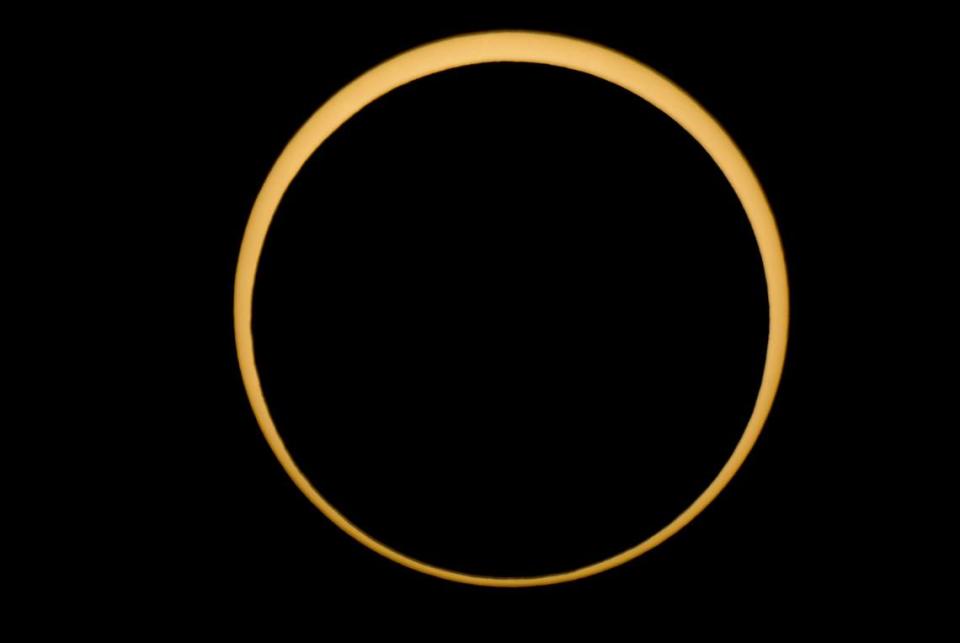Partial solar eclipse to darken Sacramento sky this weekend as others witness ‘ring of fire’
A rare annular solar eclipse will appear over the California sky this weekend, and Sacramento planetariums will be hosting families and star-gazers for viewing.
On Saturday, a small sliver of the state — roughly 300 miles north of the capital city — will see what scientists are calling a “ring of fire.” Unlike a total eclipse where the moon fully covers the Sun, an annular one is when the Moon appears smaller and won’t block the whole Sun, leaving its edges visible.
“Solar eclipses, in general, are not necessarily that rare,” said Kyle Watters, a professor of physics and astronomy at the California State University, Sacramento. “We get maybe one every other year or so somewhere on planet Earth, but it’s pretty rare for it to happen where you actually live.”
In Sacramento, the astronomical event on Saturday will appear as a partial eclipse — like a crescent moon, but it’s the sun instead. Depending on where you live in California, you’ll see a smaller or larger crescent.
“We will get a very nice partial eclipse where the Moon will cover most of the Sun,” Watters said.
Watters, who is also the school’s planetarium coordinator, said we haven’t had a “decent” eclipse since 2017.
What time is the solar eclipse?
The Moon will start covering the sun around 8 a.m. and Sacramentans will get the best view of the crescent at 9:20 a.m. At this time, the Moon will be at the Sun’s center and the “ring of fire” will appear in Alturas.

Where can you see the full annular eclipse in California?
According to NASA, Alturas, in Modoc County by the Shasta Cascade region of Northern California, is the only part of the state in which the “ring of fire” will be visible.
The path of the annular eclipse will also go through Nevada, Utah, New Mexico and Texas, as well as a sliver of Arizona and Colorado.

Solar eclipse viewing events in Sacramento
At Sacramento State
Sacramento State’s planetarium at 6000 Jed Smith Drive is hosting a free event.
From 8 to 11 a.m., Watters said they’ll be giving out 500 pairs of eclipse glasses to guests. There will be telescopes, crafts for kids and free planetarium shows.
No reservations are required and people can park for free in the garage near the student bookstore and planetarium.
“We’re ready for hundreds of people,” Watters said. “... We’re looking forward to bringing people out and teaching them a little bit about our solar system and about how eclipses work, and getting a good view of this particular eclipse.”
At SMUD’s Museum of Science and Curiosity
The MOSAC is hosting a free viewing party near the museum at Matsui Park, 450 Jibboom St., from 7:30 to 11 a.m.
Jeff Rodgers, manager of public programs and the dome theater at MOSAC, said there will be free viewing goggles, solar telescopes and activities.
Parking is limited, but guests can pay $6 to park at the museum. There will be volunteers who’ll help direct people to the viewing area.
Anytime we can get people to look up in the sky and ask questions about how the universe works is a great day, Rodger said.
How to view the solar eclipse safely from home
If you’re planning to catch the eclipse at home, be sure you’re doing it safely.
“It’s still not safe to look at the sun with your naked eye, even with the moon blocking like 85% of it,” Watters said. “The Sun is still way too bright for your eyes.”
You’ll need proper protection with eclipse glasses, which are much darker than regular sunglasses.
Watters said you can also use a kitchen colander and hold it up to the Sun to cast shadows onto the ground. During the eclipse, he said the images will be little crescents.
What do you want to know about life in Sacramento? Ask our service journalism team your top-of-mind questions in the module below or email servicejournalists@sacbee.com.

